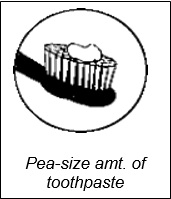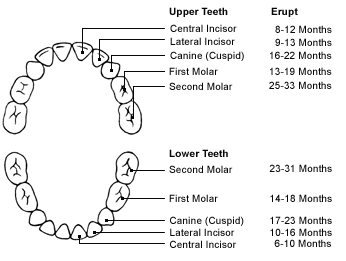Infants, Tots, Pregnancy… & Teeth
Before Baby is Born – things to know:
1) Tooth-decay causing bacteria can be transmitted from mother to child so it is important to have maternal teeth free of decay.
2) During pregnancy expecting moms tend to snack more and while this is perfectly healthy it does make the teeth more prone to cavity-causing bacteria. Unclean teeth accumulate plaque, which not only leads to tooth decay but can also irritate the gums and cause gingivitis.
3) Due to high hormone levels, expecting moms are more prone to gingivitis from the second through the eight month of pregnancy. Gingivitis may lead to adverse pregnancy outcomes such as low birth weight in the baby or premature delivery.
4) If you suffer from morning sickness, remember to rinse out your mouth with water after vomiting. This neutralizes the stomach acid that can destroy tooth enamel. If you can, wait a bit before eating, drinking or brushing your teeth. Acidic foods and some abrasive materials in toothpaste can further damage teeth that are weakened by frequent vomiting.
5) Diet is also incredibly important to your dental health during pregnancy as diet can affect the formation of the unborn baby’s teeth. Baby’s teeth begin to form during the second month of pregnancy and tooth enamel begins to harden between the third and sixth month. It is recommended to eat a diet full of Vitamins A, C, D, protein, calcium and phosphorous, so as to ensure the proper formation of the teeth and their enamel. Contrary to popular belief, breast feeding does not take calcium out of the mother’s teeth; only out of bone when the mothers’ diet is lacking in calcium.
6) Xylitol is a safe, natural sweetener that inhibits cavity-forming bacteria; pregnant women can benefit from chewing xylitol gum and//or using other xylitol products such as toothpaste or mouthrinse for cavity prevention.
Oral Health as an Infant:
A baby is born with all 20 of their primary teeth present beneath their gums. The majority of these teeth are already fully developed, though a few teeth continue to form over the next few months after birth. These teeth function to hold space in the jaws for the permanent teeth and to give the face its shape and form. Begin cleaning a baby’s mouth the first few days after birth. A good way to do this is by wiping the baby’s gums with a clean, wet gauze pad or washcloth after every feeding. Wiping the mouth in this way is a good way to clean teeth until the back teeth begin to erupt (come through gums). In addition, this helps the child become accustomed to having their mouth checked. To soothe sore or tender gums while teeth are erupting it is recommended to rub the gums with a clean finger or a wet gauze pad and/or provide a clean teething ring to chew. It is NOT recommended to dip the ring in sugar or syrup, but refrigerating the ring can help it be more soothing. When teeth appear, start using a soft children's toothbrush twice a day.
Toddlers and Teeth:
When Should I Start Taking my Child to the Dentist?
The American Dental Association recommends that parents take their child to a dentist no later than his or her first birthday so the child becomes comfortable with his or her dentist. This gives the dentist a chance to evaluate level of risk for dental problems and determine a prevention plan that is individualized for each patient with the goal of preventing problems before they start. Factors typically evaluated during a caries (cavity/decay) risk assessment include discussing with parents: eating and drinking habits including bottle use, oral hygiene, plaque accumulation, the amount of fermentable carbohydrates consumed, previous caries history, and fluoride exposure. Anatomic susceptibilities, early colonization of bacteria, family history of oral health and caries, low salivary flow, and presence of special needs should all be considered because they can contribute to high decay rates. Additionally, and sucking, swallowing, and mouth- breathing habits are important to monitor as is progress with oral development.
Baby Bottle Decay

One serious form of decay among young children is baby bottle tooth decay.
This condition is caused by frequent and long exposure of an infant's teeth to liquids that contain sugar. Among these liquids are milk (including breast milk), formula, fruit juice and other sweetened drinks. Putting a baby to bed for a nap or at night with a bottle containing anything other than water can cause serious and rapid tooth decay. Sweet liquid pools around the child's teeth giving bacteria an opportunity to produce acids that attack tooth enamel. If you must give your baby a bottle as a comforter at bedtime, it should contain only water. Bottle use after age 1 is discouraged.
Is Fluoride Helpful?

Developing teeth can certainly benefit from a little fluoride. This mineral prevents tooth decay by strengthening tooth enamel and making it more resistant to acids and harmful bacteria. The American Academy of Pediatric Dentistry recommends, however, waiting until your child is at least 2 to use fluoridated toothpaste. This is because young children tend to swallow their toothpaste rather than spit it out, and swallowing too much toothpaste over time can lead to fluorosis (enamel malformation). Children between the ages of 2 years and 6 years should use a smear of fluoridated toothpaste, and children older than 6 years of age should use a pea-sized amount (see diagram on left). As long as parents are dispensing the toothpaste and supervising the tooth brushing process, the benefits of fluoride far exceed the risk of some toothpaste being swallowed, especially in children at high caries risk.
The professional application of fluoride varnish or gel is very effective in caries prevention. Fluoride varnish or gel is recommended twice per year in moderate risk children. Varnish leaves a layer of calcium fluoride on the teeth that mixes with saliva and is slowly released in the mouth. This boosts remineralization potential and is bacteriostatic in high concentrations. Dimensions of Dental Hygiene. February 2011; 9(2): 38, 40, 42-43
Why it’s important: Startling Stats
The incidence of dental caries (cavities) among very young children—between the ages of 2 years and 5 years—has increased dramatically over the past 20 years. The National Health and Nutrition Examination Survey, 1999 to 2004, reported that 27.9% of children age 2 years to 6 years had caries in their deciduous teeth. Among those children with decay, 75% had not received any restorative care. Today, Early Childhood Caries – ECC,is considered a multifactorial disease that affects approximately 18% of American children annually. ECC is a rapid and rampant form of disease that can compromise a child’s self-esteem, nutritional intake, and oral development. The Surgeon General cites ECC as one of the most important public health diseases facing our nation! Let us do all we can to keep our children cavity free!
1.National Institute of Dental and Craniofacial Research. Dental Caries in Children (Age 2 to 11). Available at: www.nidcr.nih.gov/DataStatistics/FindDataByTopic/DentalCaries/DentalCariesChildren2to11. (Accessed January 27, 2011).
2. US Department of Health and Human Services. Oral Health in America: A Report of the Surgeon General . Rockville, Md: US Department of Health and Human Services, National Institute of Dental and Craniofacial Research, National Institutes of Health; 2000.


